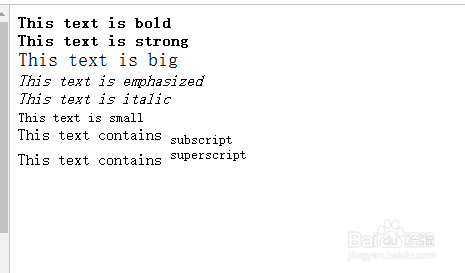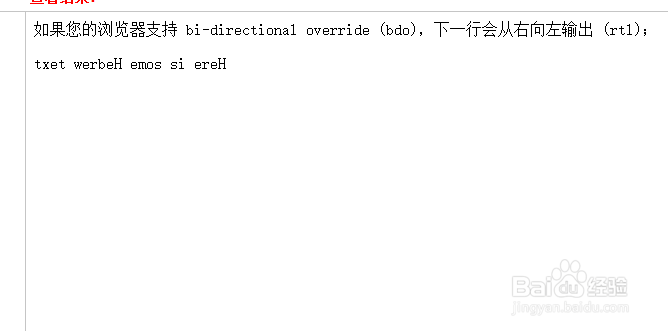HTML学习之HTML格式化
1、文本格式化此例演示如何在一个 HTML 文件中对文本进行格式化代码如下:<html><body><b>This text is bold</b><br /><strong>This text is strong</strong><br /><big>This text is big</big><br /><em>This text is emphasized</em><br /><i>This text is italic</i><br /><small>This text is small</small><br />This text contains<sub>subscript</sub><br />This text contains<sup>superscript</sup></body></html>

2、预格式文本此例演示如何使用 pre 标签对空行和空格进行控制。<html><body><pre>这是预格式文本。它保留了 空格和换行。</pre><p>pre 标签很适合显示计算机代码:</p><pre>for i = 1 to 10 print inext i</pre></body></html>

3、“计算机输出”标签此例演示不同的“计算机输出”标签的显示效果。<html><body><cod髫潋啜缅e>Computer code</code><br /><kbd>Keyboard input</kbd><br /><tt>Teletype text</tt><br /><samp>Sample text</samp><br /><var>Computer variable</var><br /><p><b>注释:</b>这些标签常用于显示计算机/编程代码。</p></body></html>

4、地址此例演示如何在 HTML 文件中写地址。<!DOCTYPE html><html><body><address>Written by <a href="mailto:webmaster@example.com">Donald Duck</a>.<br>Visit us at:<br>Example.com<br>Box 564, Disneyland<br>USA</address></body></html>

5、缩写和首字母缩写此例锿洞斜嗤演示如何实现缩写或首字母缩写。<html><body><abbr title="稆糨孝汶;etcetera">etc.</abbr><br /><acronym title="World Wide Web">WWW</acronym><p>在某些浏览器中,当您把鼠标移至缩略词语上时,title 可用于展示表达的完整版本。</p><p>仅对于 IE 5 中的 acronym 元素有效。</p><p>对于 Netscape 6.2 中的 abbr 和 acronym 元素都有效。</p></body></html>

6、文字方向此例演示如何改变文字的方向。<html><body><p>如果您的浏览器支持 bi-directional override (bdo),下一行会从右向左输出 (rtl);</p><bdo dir="rtl">Here is some Hebrew text</bdo></body></html>

7、块引用此例演示如何实现长短不一的引用语。<html><body>这是长的引用:<blockquote>这是长的引用。这是长的引用。这是长的引用。这是长的引用。这是长的引用。这是长的引用。这是长的引用。这是长的引用。这是长的引用。这是长的引用。这是长的引用。</blockquote>这是短的引用:<q>这是短的引用。</q><p>使用 blockquote 元素的话,浏览器会插入换行和外边距,而 q 元素不会有任何特殊的呈现。</p></body></html>

8、删除字效果和插入字效果此例演示如何标记删除文本和插入文本。<html><body><p>一打有 <del>二十</del> <ins>十二</ins> 件。</p><p>大多数浏览器会改写为删除文本和下划线文本。</p><p>一些老式的浏览器会把删除文本和下划线文本显示为普通文本。</p></body></html>
